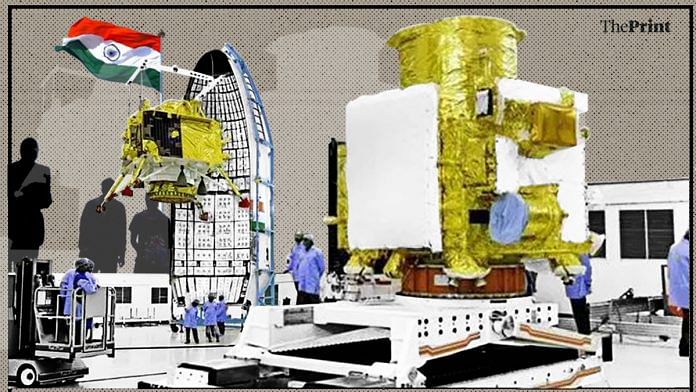India is all set to launch its second mission to the moon, Chandrayaan-2, Monday. ISRO’s Rs 603-crore spacecraft will take flight in a Rs 375-crore GSLV-Mark III rocket (named ‘fat boy’ and ‘Baahubali’), carrying an orbiter, a lander, and a rover. Chandrayaan-2 follows China’s Chang’e 4, which landed on the far side of the moon on 3 January 2019.
ThePrint asks: ISRO Chandrayaan-2 mission: Limited to symbolic national pride or is there a scientific gain?
No PM ever addressed the nation after a successful scientific mission. This govt is good at advertising
 Prithviraj Chavan
Prithviraj Chavan
Former CM of Maharashtra and former MoS, Science and Technology
I have been involved with the Department of Space for over six years. Chandrayaan-2 mission is technically highly complex, with many new technologies that further scientific knowledge. The mission is also the result of India’s greatest scientists working together.
The success of the mission will be a matter of great pride for the country.
Any mission accomplished successfully is a matter of pride for its participants. I don’t remember any prime minister previously addressing the nation on TV upon the success of a scientific or technological mission like the recent anti-satellite tests. And this government is particularly good at advertising.
There are only a handful of countries that are spacefaring today, and India is one of them. It is a matter of pride indeed.
At the same time, it enriches the confidence of scientists and engineers at ISRO and the Department of Space. The mission, in fact, increases our pride in them as well. A major scientific achievement is a matter of joy and pride, as conditions to succeed are so difficult and so many people have to come together to make such missions happen.
It is unfortunate that scientific missions are now being linked to national pride
 Somak Raychaudhury
Somak Raychaudhury
Director of the Inter-University Centre for Astronomy and Astrophysics, Pune
Of course national pride is important but that is not what the scientists will talk about. It is unfortunate that scientific missions are now being linked to national pride.
Mangalyaan-1 and Chandrayaan-1 were exploratory missions to just find out whether India can successfully carry out Mars and moon missions. The scientific gains from these missions have been some, but not overwhelming. So, Chandrayaan-2 mission is certainly not just about national pride. It not only targets some key scientific issues but also tests capabilities that have hold long-term promises.
One, this is the first time that India will attempt a moon landing. That itself is a fantastic test for what the country can do.
With Chandrayaan-2, NASA is sending a mirror, which will be placed in the unchartered territory of the moon. With laser reflections from this mirror, NASA can get more precise values for the distance between the moon and the earth. This shows how far ISRO’s space missions have progressed over the decades.
At some point in the future, we will have to go out there in deep space and set up colonies. Whatever our long-term plans may be, the first stop has to be moon. It is similar to travelling on a large highway, where you need fuelling stations, or rest stops.
So, we need a station out there, where you will assemble things for the next stage flight. For that, we need to understand the entire moon: we don’t want any surprises.
Countries like the US, Russia and China have already done a lot in this regard. India, too, has to have its long-term planetary exploration attempts independent of other countries. This is what makes missions like Chandrayaan-2 very vital.
Technological competencies achieved in such missions can act as building blocks to serve other sectors
 Narayan Prasad
Narayan Prasad
Co-founder, Satsearch.co
Space missions provide direct benefit transfers to society by way of knowledge and capacities that they generate in the process of achieving mission requirements. Investments into missions such as Chandrayaan-2 are not only for scientific purposes but they also have immense, long-term implications for use in various applications in local industries. Technological competencies established in the process of enabling the science to happen on the lunar surface – such as radiation-hardened electronics, remote navigation and communication technologies, design of robotic platforms, etc. – can act as baseline building blocks to serve requirements in nuclear, defence, medical, and energy industries.
Apart from the spin-off benefits, such complex scientific missions challenge the engineers to push the boundaries in capabilities that the country has in crafting the use of fundamental technologies such as hi-tech semiconductors, autonomous operations, fault-tolerant software architectures, and design of systems to survive extreme environments. These technological advancements are not designed to be specifically used in future only inspace missions. This is clear from the most recent example of the large-scale interest and adoption of ISRO-developed lithium ion batteries by the industries interested in electric mobility.
It may take long for such technologies to trickle down, but past examples clearly show the benefits of pursuing space missions.
Also read: Check out India’s biggest indigenous rocket as ISRO readies for Chandrayaan 2 launch
Sharing limited information about previous mission outcomes severely affected subsequent missions
 Siddharth Pandey
Siddharth Pandey
Head, Centre of Excellence in Astro-biology, Amity University Mumbai
Though it took India over a decade to come up with its second moon mission, the ambitious Chandrayaan-2 project is a matter of pride and will definitely reignite the passion among Indians to explore extra-terrestrial surfaces.
India is poised to draw maximum scientific benefits from Chandryaan-2, since it is planning to rove a relatively less explored region on the moon – one that is closer to the south pole. There are several important instruments on the orbiter, lander and rover that will reveal important insights about the lunar surface/subsurface geology, water distribution and seismology. Particularly, the dual frequency synthetic aperture radar (DFSAR) on the orbiter, and alpha particle X-ray spectrometer (APXS) and laser induced breakdown spectroscope (LIBS) on the rover have the potential for high-impact science, revealing critical elemental abundances, distribution and water/hydroxyl presence. This will give information about the moon’s formation, its present structure, as well as its potential to serve as a habitational/refuelling post for future missions to Mars and beyond.
However, it will be important that the collected raw and processed data is disseminated to the scientific community in an open and timely manner. We have seen how limited information about previous mission outcomes has been released, severely affecting the planning and development of future missions. There needs to be open interaction between India’s scientific community and the ISRO for science to flourish and enhance future missions.
Also read: All set for Moon mission, ISRO unveils images of Chandrayaan 2 lander, rover, orbiter
Everyday technologies we use are the results of several such space programmes
 Sandhya Ramesh
Sandhya Ramesh
Senior assistant editor of Science, ThePrint
Whether the mission instils national pride or not, it provides immense scientific and technological value to common citizens. Everyday technologies we use are the results of several nations’ space programmes: scratch-resistant glasses, camera phones, memory foam, baby formula, LASIK eye surgery, and more.
The rest of the universe spreads out all around our insignificant planet. As we advance as a species, we develop both increased curiosity and better technology to explore it. In the face of the ongoing climate crisis, there is hope that some solutions to our problems will come from space.
India is taking a giant leap, with other nations clamouring to play catch up with the Cold War giants of space exploration. At the same time, India is also collaborating with other countries and establishing for itself a firm and strong foothold that will lead it into the future of science.
By Sandhya Ramesh and Mohana Basu.




The results or spin offs from such a venture cannot be measured in terms of any ultimate commercial benefit.Dabbling in high tech exercises is a must for any country and India is no exception. The results of such exercises are the building blocks for a strong foundation on which our scientists and engineers can build more advanced systems with greater confidence.
Many useful spinoffs from space odysseys. However, manned space flights are a costly indulgence. Better to stick to missions that are cost effective.